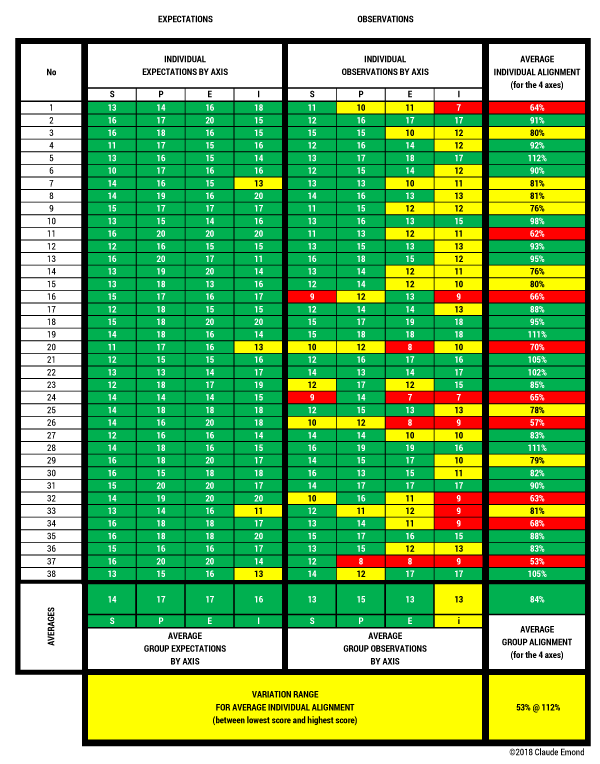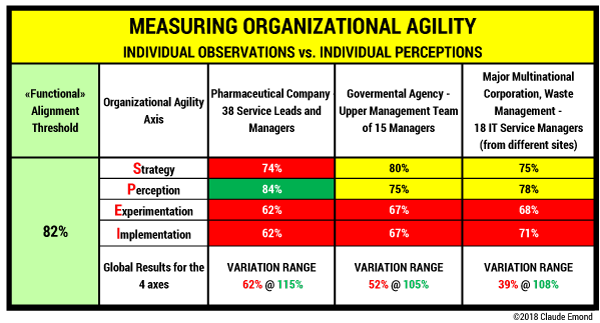BA & SEE EXECUTIVE UPDATE VOL. 19, NO. 9

Organizational agility has been a talking point since the beginning of this century. Nowadays, it is the holy grail of organizational development for most businesses. A Google search returns upwards of 7,370,000 results, the first of which are of course ads promoting an event, a service, or a product that promises to help achieve superior organizational agility in a flash.
First Things First: What Is Organizational Agility and Why Do We Need It?
Many still believe that an organization can become agile through the adoption and use of specific Agile methodologies, while keeping all other organizational parameters stable. More and more people, however, understand that agility does not come easily and that it is more a question of culture and values than a question of using specific methods and tools.
In their search for greater organizational agility, people also encounter many definitions of this expression. Allow me to propose my own definition, based on my experience with how agility manifests itself in teams and other organizations, which I believe encompasses the essence of what it means for an organization to be agile:
Organizational agility is the capacity and ability of the members of a team and/or of an organization to collectively transform themselves — to learn, to innovate, to reorganize, to redefine themselves, and to adapt together to new, emerging situations — very quickly and continuously, in a forever-changing environment.
The “forever-changing environment” is documented in many publications today under the expression “VUCA environment.” VUCA is an acronym for: volatile, uncertain, complex, and ambiguous. Greater organizational agility is required to keep growing and prospering in a VUCA-type environment. The aim is to sustainably accelerate and increase the materialized benefits and global value created by the organization for all its stakeholders.
In a recent webinar my wife and I led for PMI-France, 82% of the 200-plus participants were hearing about VUCA for the first time and had no clue what it meant. I find a similar lack of knowledge about VUCA among more than 70% of the participants in my conferences and workshops on agility. This is quite disturbing, considering that the VUCA quality of your business environment is the reason why you need to be more agile. There are more people who work on improving organizational agility than people who know why this should be required. How can you work on something when you do not know why you should do it?
The Management Team: The Foundation of Organizational Agility
There is no such thing as a dysfunctional organization, because every organization is perfectly aligned to achieve the results it gets.
— Ronald Heifetz, Alexander Grashow, and Marty Linsky, The Practice of Adaptive Leadership
So, before working on transforming our organizations to become more agile, maybe we should discuss the business environment and make sure everybody in the organization sees the same one. Then we should look at our internal organizational environment and make sure everyone has the same expectations and the same perceptions of it.
Why is this important for organizational agility? Because superior organizational agility, if you understand and accept the definition I proposed above, cannot be achieved if we cannot act together. To act together, we must:
-
Be aligned in our individual observations and understanding of both our business and internal organizational environments, and …
-
Have the same expectations and level of engagement with respect to how we want to change things around and work together with more agility.
We cannot presume that this alignment and same level of engagement exist. We must measure both and ensure both, and this starts with upper management.
If the management team is not aligned and equally engaged toward the same purpose, the transformation of the whole organization to become more agile is impossible. Superior agility derives from superior alignment and engagement of all concerned, and the first step must be aligning and engaging upper management. It is impossible for employees to be aligned to the same mission and the same objective if these are not clearly communicated and reflected in the actions of all their leaders.
Looking at your own organization, ask yourself these three questions:
-
As leaders and managers, are we coherent in our intent to promote and implement agility collectively?
-
Do our individual actions reflect the intent we communicate to our employees?
-
As a management team, do we have the same definition, the same individual expectations, and the same understanding of what is and should be the level of agility of our organization?
If your answer to one or more of these three questions is “no,” or if you cannot answer one or more, you will not be able to engage your employees in a collective transformation toward greater organizational agility.
The 4 Axes of Organizational Agility
We cannot measure organizational agility from a simple definition, not even the one proposed above. We must break down this definition into some measurable elements and build a measurement tool around those elements. Luckily for us, many scholars and others have worked on developing such tools.
One such tool has been developed at the University of Southern California (USC) and its Center for Effective Organizations. It exists in two formats: an extensive 67-point self-assessment and a shorter 19-point high-level self-assessment.1 I like this assessment tool because it considers agility as expressing itself over four simple axes: strategy, perception, experimentation, and implementation. The tool is not only simple, it also makes a lot of sense, as the axes can be directly associated with the four elements of military strategist John Boyd’s OODA loop (observe, orient, decide/discover, and act). The measurement sequence of the tool starts with some “orient” elements, instead of “observe” elements. This does not really matter, however, since OODA is a cycle. You can start wherever you want in the loop, and you will eventually end up observing before orienting, since once you observe, decide/discover, and act, you will reorient your strategy based on new observations and facts.
Here are the four axes:
- Strategic agility (orient). How the management team:
- Selects a higher purpose and an ambitious goal for the organization
- Develops a dynamic, adaptive strategy shared by all employees and other collaborators
- Manages the workplace and engages the whole organization in implementing this strategy
- Perceptual agility (observe). How the organization, as a whole:
- Scans and observes both its external business environment and its internal organizational interactions scientifically and in a continuous manner
- Can effectively detect new changes as they emerge
- Can rapidly communicate factual observations and perceptions (subjective individual observations) to decision makers for analysis and subsequent formulation of proper responses and action plans
- Experimentation agility (decide/discover). How the organization:
- Designs prototype solutions
- Plans and executes those experiments
- Learns from those prototypes and adjusts future action plans accordingly
- Implementation agility (act together). How the organization maintains and improves:
- Its ability and its capacity to implement desired changes
- Its capacity to evaluate the effect of its implemented action plans, their contribution to the resulting organizational performance, and the benefits realized
To get upper management to contemplate self-assessing organizational agility, I believe, based on my own experience, that the assessment must be short and sweet. Thus, I began using the short version of the USC self-assessment tool with managers.
The USC tool includes some threshold-level information based on research data. If your score on an axis is at or above the threshold level, it means that your organization is functionally agile for that axis. If your score is under the threshold level for the implementation agility axis, your organizational agility is just not working, because you are unable to put that agility into action in your daily operations.
Measuring Individual Expectations and Perceptions
The USC self-assessment tool measures individual observations along the four agility axes (strategic, perceptual, experimentation, implementation) and compares the results with the functionality threshold level the researchers set for each axis.
It does not provide measurement data on individual expectations and the resulting engagement level of those completing the self-assessment, so I decided to modify the original USC tool and adapt it to measure engagement as well as multiple alignment parameters,2 namely:
-
Collective alignment with respect to individual observations
-
Collective alignment with respect to individual expectations
-
Individual alignment between individual observations and individual expectations
The measurement of individual alignment between “individual observations” and “individual expectations” gives us an idea of a person’s level of engagement and desire for change. This measurement is an indirect indication of both individual drive for change and individual level of engagement, considering the current state of the organization observed by the person completing the self-assessment. The lower the individual alignment (ratio of “individual observations” over “individual expectations”), the lower the person’s level of engagement, but also the stronger the person’s drive for change. Clancy and King have found that an individual alignment ratio lower than 82% is dysfunctional and must be addressed.
My self-assessment tool includes the measurement of the three types of alignment mentioned above, thus enabling us to measure individually and collectively both alignment and engagement with respect to superior organizational agility.3
Some Empirical Results
Once the (upper) management team decides to go through these individual self-assessments, what are we likely to find? Let me share some results based on my experience with willing management teams. I am quite sure you will find the same patterns in your organization.
The first finding is a surprise to many researchers. During one of our experimentations with the tool, many university researchers were present. One of them told us that measuring expectations would cause chaos because expectations are so different from one person to another. Well?

This is not what we consistently find. Figure 1 illustrates a typical result sample from the self-assessment. This sample comes from 38 self-assessors belonging to a school directors and managers association; the people represent a variety of very different schools.
The green cells mean that expectation or observation self-assessment results are equal to or above the “functional” agility thresholds, as defined by USC, or equal to or above the “functional” alignment ratio threshold of 82%, as defined by Clancy and King. The yellow cells mean that the results are slightly below “functional” agility or alignment, and the red cells indicate “dysfunctional” agility or alignment.
The last line of the table in Figure 1 shows the variation range for average individual alignment ratio results. For this specific sample survey, the variation is between 53%, the lowest, and 112%, the highest average individual alignment ratio score. All alignment ratio scores of over 100% indicate that the respondents with these scores had higher global individual observation scores than their individual expectation scores for organizational agility. A score above 100% suggests that these respondents were very happy with the current agility level they observed in their organization, as it was above their personal expectations. We can deduce from these high scores that it would be difficult to engage these respondents in an organizational change that they do not deem necessary; their drive for change is very low, and it is likely that their first reflex would naturally be to resist any change in their work environment.
In matters of expectations, we find exactly the contrary of the chaos the university researcher predicted. Basically, the sample shows that practically all respondents have the same expectations for highly functional agility, although they do not observe the same organizational reality.
We obtained very similar results in all the groups and teams we measured. We believe that is so because the 19 elements measured on the shorter USC assessment are very high level and that, at a high conceptual level, everyone basically desires what an agile workplace has to offer; that is, a purposeful, collaborative, trusting, innovative, caring, human-centered environment. Everyone is for virtue and greater well-being.
Once we understand that, we can conclude that, if we measure misalignment with respect to the individual perception/observation ratios, we effectively measure, most of the time, both of the following:
-
Misalignment in the observations and understanding of the current situation in the organization — we do not work at the same place
-
Engagement issues — unhappiness and drive for change
Figure 2 shows the organizational agility self-assessment results for the management teams of three different organizations: 38 service leaders and managers from a pharmaceutical company, 15 members of the upper management team of a governmental agency, and 18 IT service managers working at 18 different sites for the same multinational waste management corporation.

for the management teams of three different organizations.
As with the sample survey results shown in Figure 1, individual expectations in all three organizations were mostly similar: a wish for highly functional agility. Likely, individual observations differed, due to different personal perceptions, impressions, and understanding of what was observed.
Except for the last line, which presents the variation range between the lowest and the highest average individual alignment scores of the respondents from each of those three organizations, all the data in Figure 2 refers to the respondents’ average observation/expectation alignment ratios (in percentages). Remember that the lower the alignment ratio, the lower the engagement but the stronger the drive for change.
Globally, the management people self-assessed in these three organizations were not doing that well with respect to their average collective alignment between perceptions and expectations. These results are not at all negative, however, since they indicate a willingness (drive for change) to engage in an important transformation toward functional agility, given that most of the respondents technically desire better organizational agility and understand that it must be achieved. Of course, individual respondents with alignment ratio scores of 100% and above will have to be managed closely, as they are likely to initially resist any change to a work environment that they already consider to be more than perfect for them, since what they have observed surpasses their personal expectations.
Where Do We Go from Here?
Before embarking on a transformation toward functional agility, these management teams must:
-
All agree on the same objectives
-
Show the same intent to work toward those objectives and to mobilize their employees
-
Support their employees in the transition
-
Communicate with their employees accordingly
To do that, as a unified management team, they must sit together and deal transparently with the individual variations in the alignment ratio results.
One big issue is dealing with those respondents with alignment ratio scores equal to 100% and above, even if the average collective alignment is below the threshold of functional agility. Those managers are telling us, through their self-assessments, that they are quite happy with the status quo, and thus are likely unwilling to embark on a transformation to become more agile as individuals and as an organization.
Unless all the members of the management team are willing to embark together on this transformation journey with collective coherence, solidarity, and intent, the team won’t be able to even begin this journey; it will be doomed from the start.
Final Remarks
Before the management team aligns itself with respect to a shared organizational transformation purpose, some soul-searching will have to be done with respect to the common business environment, in terms of its VUCA elements.
I have not yet found an instrument to objectively determine the VUCA index of the business environment. I have designed a high-level self-assessment that does the job intuitively, but we could do a lot better. However, the use of this simple intuitive self-assessment has shown that people coming from the same organization do not see the same business environment. In general, I have found the following to be true:
-
The closer the respondent is to the client market (CEO, marketing/sales personnel), the more likely the respondent is to have a better gut feeling for what the actual VUCA index is.
-
The farther from the client market the respondent is (daily production/operations and floor personnel, technical support, etc.), the less likely the respondent is to know the exact nature of the external business environment.
I believe that everyone in the same organization should have a shared basic understanding of its outside VUCA business environment, and this shared understanding must exist before discussing a move toward more organizational agility. If the VUCA index is not collectively shared, the why of being or becoming more agile will not be understood, and the transformation will fail.
Consequently, I strongly suggest that (upper) management teams make sure that everyone in the organization understands what is going on in the organization’s environment. Once this common understanding of why has been attained across the organization, the next thing to do is for the management team to measure and ensure its own collective alignment and engagement, before asking anybody else to embark on any transformation, be it for better organizational agility or any other endeavor whatsoever.
Such is the first step of any successful organizational transformation.
1 The shorter version is described in Assessing Organization Agility: Creating Diagnostic Profiles to Guide Transformation.
2 The idea of measuring both individual expectations and individual observations comes from my work with Wayne Clancy and John King (coauthor of Tribal Leadership), with whom I am collaborating on the improvement of the Humanizing Performance GPS, a self-assessment tool developed in association with Arizona State University, Project Humanities.



